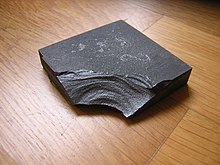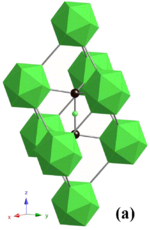| Revision as of 03:59, 25 May 2011 editSbharris (talk | contribs)38,989 editsNo edit summary← Previous edit | Revision as of 04:18, 25 May 2011 edit undoMaterialscientist (talk | contribs)Edit filter managers, Autopatrolled, Checkusers, Administrators1,994,328 editsm polymeric would be understood as a true polymer; B4C is not a name, but inability to type subscript; black diamond is diamond; there is no 9.3 MohsNext edit → | ||
| Line 6: | Line 6: | ||
| | ImageName = Boron carbide | | ImageName = Boron carbide | ||
| | IUPACName = Boron carbide | | IUPACName = Boron carbide | ||
| | OtherNames = Tetrabor |
| OtherNames = Tetrabor | ||
| | Section1 = {{Chembox Identifiers | | Section1 = {{Chembox Identifiers | ||
| | ChemSpiderID_Ref = {{chemspidercite|correct|chemspider}} | | ChemSpiderID_Ref = {{chemspidercite|correct|chemspider}} | ||
| Line 29: | Line 29: | ||
| | MeltingPtC = 2763 | | MeltingPtC = 2763 | ||
| | BoilingPtC = 3500 | | BoilingPtC = 3500 | ||
| | pKa = |
| pKa = 6–7 (20 °C) | ||
| }} | }} | ||
| | Section3 = {{Chembox Structure | | Section3 = {{Chembox Structure | ||
| Line 48: | Line 48: | ||
| }} | }} | ||
| '''Boron carbide''' (chemical formula approximately B<sub>4</sub>C) is an extremely hard ]-] ] |
'''Boron carbide''' (chemical formula approximately B<sub>4</sub>C) is an extremely hard ]-] ] material used in ] ], ]s, and numerous industrial applications. With a ] of above 9, it is one of the hardest materials known, behind cubic ] and ]. | ||
| Boron carbide was discovered in the 19th century as a ] of reactions involving metal borides, however, its ] was unknown. It was not until the 1930s that the |
Boron carbide was discovered in the 19th century as a ] of reactions involving metal borides, however, its ] was unknown. It was not until the 1930s that the chemical composition was estimated as B<sub>4</sub>C.<ref>Ridgway, Ramond R , European Patent CA339873 (A), publication date: 1934-03-06</ref> There remained, however, controversy as to whether or not the material had this exact 4:1 stoichiometry, as in practice the material is always slightly carbon-deficient with regard to this formula, and ] shows that its structure is highly complex, with a mixture of C-B-C chains and B<sub>12</sub> ]. These features argued against a very simple exact B<sub>4</sub>C empirical formula.<ref name=stoi>{{cite journal|title=Structure and bonding in boron carbide: The invincibility of imperfections|author=Musiri M. Balakrishnarajan, Pattath D. Pancharatna and Roald Hoffmann|journal=New J. Chem.|year=2007|volume=31|page=473|doi=10.1039/b618493f|url=http://www.rsc.org/Publishing/Journals/nj/Hotarticles/B618493F_Hoffmann.asp}}</ref> Because of the B<sub>12</sub> structural unit, the chemical formula of "ideal" boron carbide is often written not as B<sub>4</sub>C, but as B<sub>12</sub>C<sub>3</sub>, and the carbon deficiency of boron carbide described in terms of a combination of the B<sub>12</sub>C<sub>3</sub> and B<sub>12</sub>C<sub>2</sub> units. | ||
| The ability of boron carbide to absorb neutrons without forming long lived ]s makes it attractive as an absorbent for ] arising in ]s. Nuclear applications of boron carbide include shielding, ] and shut down pellets. Within control rods, boron carbide is often powdered, to increase its surface area.<ref name=w330>Weimer, p. 330</ref> | The ability of boron carbide to absorb neutrons without forming long lived ]s makes it attractive as an absorbent for ] arising in ]s. Nuclear applications of boron carbide include shielding, ] and shut down pellets. Within control rods, boron carbide is often powdered, to increase its surface area.<ref name=w330>Weimer, p. 330</ref> | ||
| ==Crystal structure== | ==Crystal structure== | ||
| ] |
] consist of boron atoms, and black spheres are carbon atoms.<ref name=zhangyb28.5c4>{{cite journal|author=Zhang F X, Xu F F, Mori T, Liu Q L, Sato A and Tanaka T|year=2001|title=Crystal structure of new rare-earth boron-rich solids: REB28.5C4|journal=J. Alloys Compd.|volume=329|page=168|doi=10.1016/S0925-8388(01)01581-X}}</ref>]] | ||
| ] | ] | ||
| Line 66: | Line 66: | ||
| ==Preparation== | ==Preparation== | ||
| Boron carbide was first synthesized by ] in 1899 |
Boron carbide was first synthesized by ] in 1899,<ref name=gr>{{Greenwood&Earnshaw2nd|p=149}}</ref> by reduction of ] either with ] or ] in presence of carbon in an electric ]. In the case of carbon, the reaction occurs at temperatures above the melting point of B<sub>4</sub>C and is accompanied by liberation of large amount of carbon monoxide:<ref name=w131>Weimer, p. 131</ref> | ||
| :2 B<sub>2</sub>O<sub>3</sub> + 7 C → B<sub>4</sub>C + 6 CO | :2 B<sub>2</sub>O<sub>3</sub> + 7 C → B<sub>4</sub>C + 6 CO | ||
| If magnesium is used, the reaction |
If magnesium is used, the reaction can be carried out in a ], and the magnesium byproducts are removed by treatment with acid.<ref>Pradyot Patnaik. ''Handbook of Inorganic Chemicals''. McGraw-Hill, 2002, ISBN 0070494398</ref> | ||
| ==Uses== | ==Uses== | ||
| Line 90: | Line 90: | ||
| ==External links== | ==External links== | ||
| * | * | ||
| * | * | ||
Revision as of 04:18, 25 May 2011
 | |
| Names | |
|---|---|
| IUPAC name Boron carbide | |
| Other names Tetrabor | |
| Identifiers | |
| CAS Number | |
| 3D model (JSmol) | |
| ChemSpider | |
| ECHA InfoCard | 100.031.907 |
| PubChem CID | |
| CompTox Dashboard (EPA) | |
InChI
| |
SMILES
| |
| Properties | |
| Chemical formula | B4C |
| Molar mass | 55.255 g/mol |
| Appearance | dark gray or black powder, odorless |
| Density | 2.52 g/cm, solid. |
| Melting point | 2,763 °C (5,005 °F; 3,036 K) |
| Boiling point | 3,500 °C (6,330 °F; 3,770 K) |
| Solubility in water | insoluble |
| Acidity (pKa) | 6–7 (20 °C) |
| Structure | |
| Crystal structure | Rhombohedral |
| Related compounds | |
| Except where otherwise noted, data are given for materials in their standard state (at 25 °C , 100 kPa).
| |
Boron carbide (chemical formula approximately B4C) is an extremely hard boron-carbon ceramic material used in tank armor, bulletproof vests, and numerous industrial applications. With a Mohs hardness of above 9, it is one of the hardest materials known, behind cubic boron nitride and diamond.
Boron carbide was discovered in the 19th century as a by-product of reactions involving metal borides, however, its chemical formula was unknown. It was not until the 1930s that the chemical composition was estimated as B4C. There remained, however, controversy as to whether or not the material had this exact 4:1 stoichiometry, as in practice the material is always slightly carbon-deficient with regard to this formula, and X-ray crystallography shows that its structure is highly complex, with a mixture of C-B-C chains and B12 icosahedra. These features argued against a very simple exact B4C empirical formula. Because of the B12 structural unit, the chemical formula of "ideal" boron carbide is often written not as B4C, but as B12C3, and the carbon deficiency of boron carbide described in terms of a combination of the B12C3 and B12C2 units.
The ability of boron carbide to absorb neutrons without forming long lived radionuclides makes it attractive as an absorbent for neutron radiation arising in nuclear power plants. Nuclear applications of boron carbide include shielding, control rod and shut down pellets. Within control rods, boron carbide is often powdered, to increase its surface area.
Crystal structure


Boron carbide has a complex crystal structure typical of icosahedron-based borides. There, B12 icosahedra form a rhombohedral lattice unit (space group: R3m (No. 166), lattice constants: a = 0.56 nm and c = 1.212 nm) surrounding a C-B-C chain that resides at the center of the unit cell, and both carbon atoms bridge the neighboring three icosahedra. This structure is layered: the B12 icosahedra and bridging carbons form a network plane that spreads parallel to the c-plane and stacks along the c-axis. The lattice has two basic structure units – the B12 icosahedron and the B6 octahedron. Because of the small size of the B6 octahedra, they cannot interconnect. Instead, they bond to the B12 icosahedra in the neighboring layer, and this decreases bonding strength in the c-plane.
Because of the B12 structural unit, the chemical formula of "ideal" boron carbide is often written not as B4C, but as B12C3, and the carbon deficiency of boron carbide described in terms of a combination of the B12C3 and B12C2 units.
Properties
Boron carbide is known as a robust material having high hardness, high cross section for absorption of neutrons (i.e. good shielding properties against neutrons), stability to ionizing radiation and most chemicals. Its Vickers hardness (38 GPa) and fracture toughness (3.5 MPa·m) approach the corresponding values for diamond (115 GPa and 5.3 MPa·m).
Preparation
Boron carbide was first synthesized by Henri Moissan in 1899, by reduction of boron trioxide either with carbon or magnesium in presence of carbon in an electric arc furnace. In the case of carbon, the reaction occurs at temperatures above the melting point of B4C and is accompanied by liberation of large amount of carbon monoxide:
- 2 B2O3 + 7 C → B4C + 6 CO
If magnesium is used, the reaction can be carried out in a graphite furnace, and the magnesium byproducts are removed by treatment with acid.
Uses
- Padlocks
- Personal and vehicle anti-ballistic armor plating.
- Grit blasting nozzles.
- High-pressure water jet cutter nozzles.
- Scratch and wear resistant coatings.
- Cutting tools and dies.
- Abrasives.
- Neutron absorber in nuclear reactors.
- Metal matrix composites.
- High energy fuel for solid fuel Ramjets.
References
- Ridgway, Ramond R "Boron Carbide", European Patent CA339873 (A), publication date: 1934-03-06
- ^ Musiri M. Balakrishnarajan, Pattath D. Pancharatna and Roald Hoffmann (2007). "Structure and bonding in boron carbide: The invincibility of imperfections". New J. Chem. 31: 473. doi:10.1039/b618493f.
- ^ Weimer, p. 330
- ^ Zhang F X, Xu F F, Mori T, Liu Q L, Sato A and Tanaka T (2001). "Crystal structure of new rare-earth boron-rich solids: REB28.5C4". J. Alloys Compd. 329: 168. doi:10.1016/S0925-8388(01)01581-X.
{{cite journal}}: CS1 maint: multiple names: authors list (link) - ^ Greenwood, Norman N.; Earnshaw, Alan (1997). Chemistry of the Elements (2nd ed.). Butterworth-Heinemann. p. 149. ISBN 978-0-08-037941-8.
- Solozhenko, V. L.; Kurakevych, Oleksandr O.; Le Godec, Yann; Mezouar, Mohamed; Mezouar, Mohamed (2009). "Ultimate Metastable Solubility of Boron in Diamond: Synthesis of Superhard Diamondlike BC5". Phys. Rev. Lett. 102: 015506. Bibcode:2009PhRvL.102a5506S. doi:10.1103/PhysRevLett.102.015506. PMID 19257210.
- Weimer, p. 131
- Pradyot Patnaik. Handbook of Inorganic Chemicals. McGraw-Hill, 2002, ISBN 0070494398
Bibliography
- Alan W. Weimer (1997). Carbide, Nitride and Boride Materials Synthesis and Processing. Chapman & Hall (London, New York). ISBN 0-412-54060-6.
External links
| Boron compounds | |
|---|---|
| Boron pnictogenides | |
| Boron halides | |
| Acids | |
| Boranes | |
| Boron oxides and sulfides | |
| Carbides | |
| Organoboron compounds | |